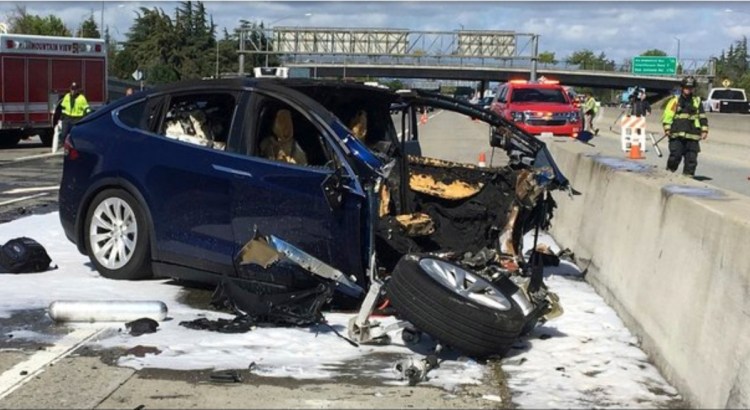Federal investigators said Sunday they were “unhappy” that Tesla had released information related to a fatal crash involving one of its Model X vehicles late last month.
Tesla announced late Friday that the Tesla Model X had its semiautonomous “Autopilot” mode activated moments before it slammed into a highway barrier on Highway 101 in California on March 23, killing driver Walter Huang, 38.
In the lead-up to the crash, shortly before 9:30 a.m., “Autopilot was engaged with the adaptive cruise control follow-distance set to minimum,” Tesla said in a blog post on its website.
Autopilot is a semiautonomous mode that can automatically change lanes and speeds based on conditions, along with maintaining the proper distance between cars and proper lane positioning. Tesla says drivers should remain attentive and keep their hands on the wheel, by touching it at set intervals, so as not to become too dependent on the technology. Tesla indicated in its statement that Huang had not been following those steps, and blamed the severity of the crash on a highway barrier known as a “crash attenuator” meant to insulate vehicles from the effects of a collision.
But the National Transportation Safety Board, which is investigating the crash, expressed concerns with Tesla’s preliminary explanation for the crash, pointing to the ongoing investigation.
“At this time the NTSB needs the assistance of Tesla to decode the data the vehicle recorded. In each of our investigations involving a Tesla vehicle, Tesla has been extremely cooperative on assisting with the vehicle data. However, the NTSB is unhappy with the release of investigative information by Tesla,” NTSB spokesman Chris O’Neil said Sunday.
The NTSB investigation was focused on the damaged collision barrier and the post-crash fire that complicated the response, according to the agency. But in the wake of revelations that Huang had previously complained about the Autopilot feature on his SUV, the NTSB said it was investigating “all aspects of this crash including the driver’s previous concerns about the autopilot.”
“We will work to determine the probable cause of the crash and our next update of information about our investigation will likely be when we publish a preliminary report, which generally occurs within a few weeks of completion of field work,” O’Neil said.
Huang’s relatives told San Francisco ABC affiliate KGO-TV that he had previously complained to the Tesla dealership about the vehicle swerving toward the median where the fatal crash occurred.
In its blog post, Tesla appeared to offer a defense for itself after the fiery wreck left the Tesla Model X a crumpled shell; its front end was shredded and the frame was charred. Tesla blamed the damaged crash attenuator, which it said had been “crushed in a prior accident without being replaced.”
The barrier serves as a buffer between vehicles and the concrete median. Investigators have said the attenuator, overseen by the California Department of Transportation, had been damaged in a previous incident and had not been reset.
“We have never seen this level of damage to a Model X in any other crash,” Tesla said.
The company also questioned whether the driver had been paying attention, though it added: “None of this changes how devastating an event like this is or how much we feel for our customer’s family and friends. We are incredibly sorry for their loss.”
Tesla said Huang had not followed guidelines intended to ensure drivers are paying attention while the vehicle is in Autopilot mode.
“The driver had received several visual and one audible hands-on warning earlier in the drive and the driver’s hands were not detected on the wheel for six seconds prior to the collision,” Tesla said. “The driver had about five seconds and 150 meters of unobstructed view of the concrete divider with the crushed crash attenuator, but the vehicle logs show that no action was taken.”
In a previous investigation into a fatal crash involving a Tesla operating in semiautonomous mode, the NTSB concluded that the driver killed in the 2016 crash with a tractor-trailer was overly reliant on the car’s Autopilot system. The system worked as intended, the safety panel said, but was not intended to replace the driver.
The NTSB had not made any conclusions Sunday on the cause of the crash or whether Autopilot or driver inattentiveness had contributed.
Tesla declined to comment on the NTSB’s concerns about it releasing information.
Send questions/comments to the editors.



Success. Please wait for the page to reload. If the page does not reload within 5 seconds, please refresh the page.
Enter your email and password to access comments.
Hi, to comment on stories you must . This profile is in addition to your subscription and website login.
Already have a commenting profile? .
Invalid username/password.
Please check your email to confirm and complete your registration.
Only subscribers are eligible to post comments. Please subscribe or login first for digital access. Here’s why.
Use the form below to reset your password. When you've submitted your account email, we will send an email with a reset code.